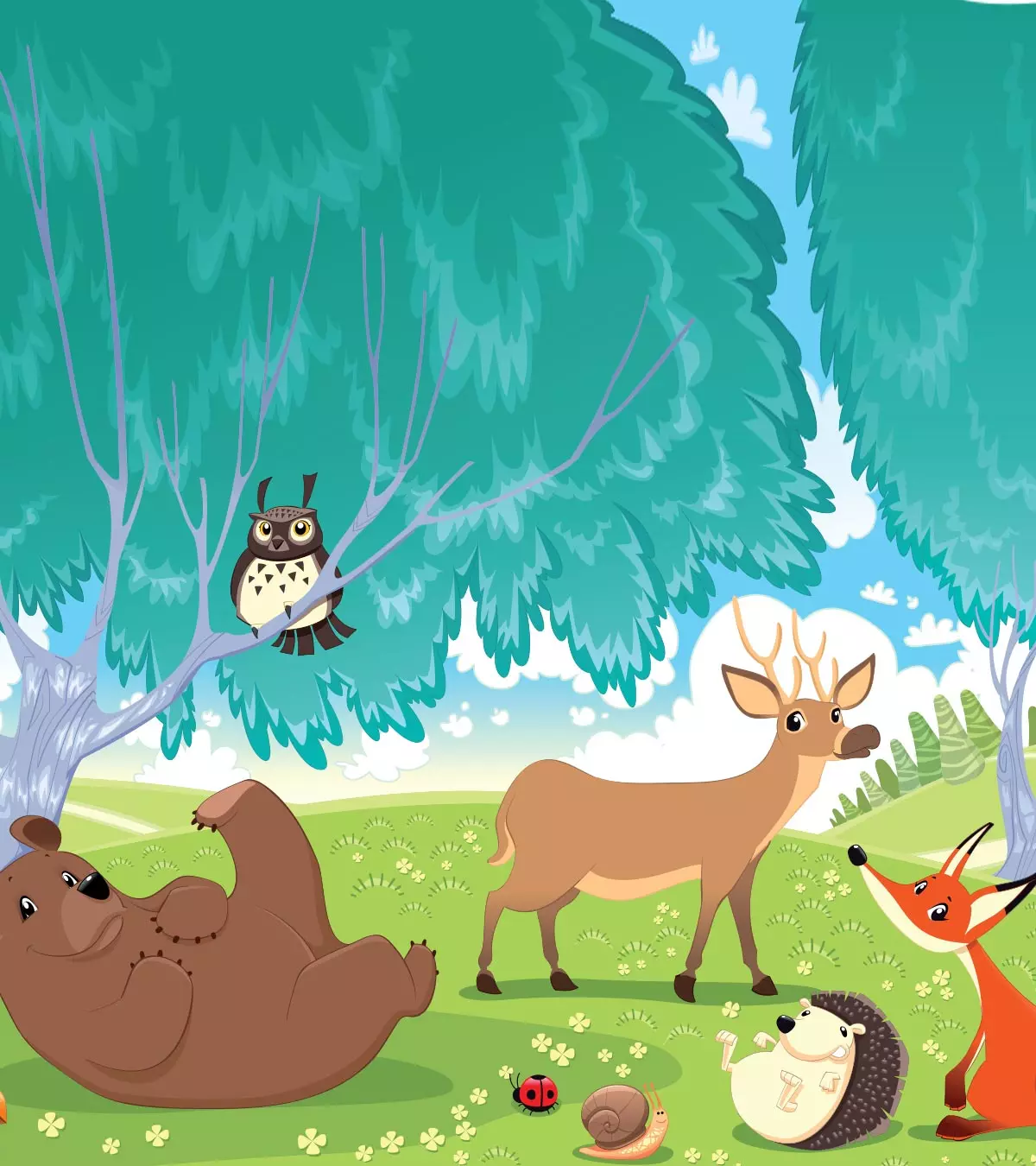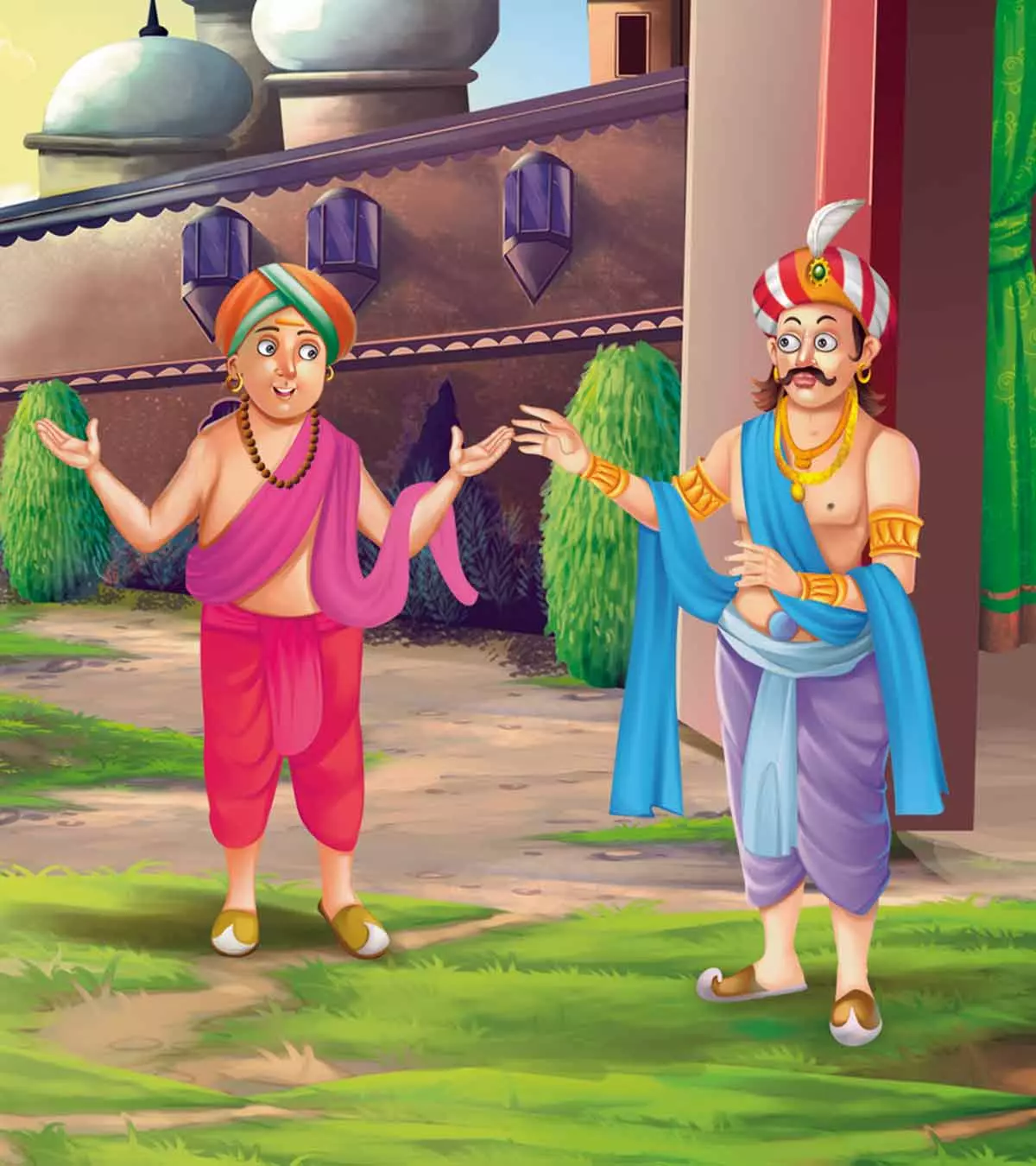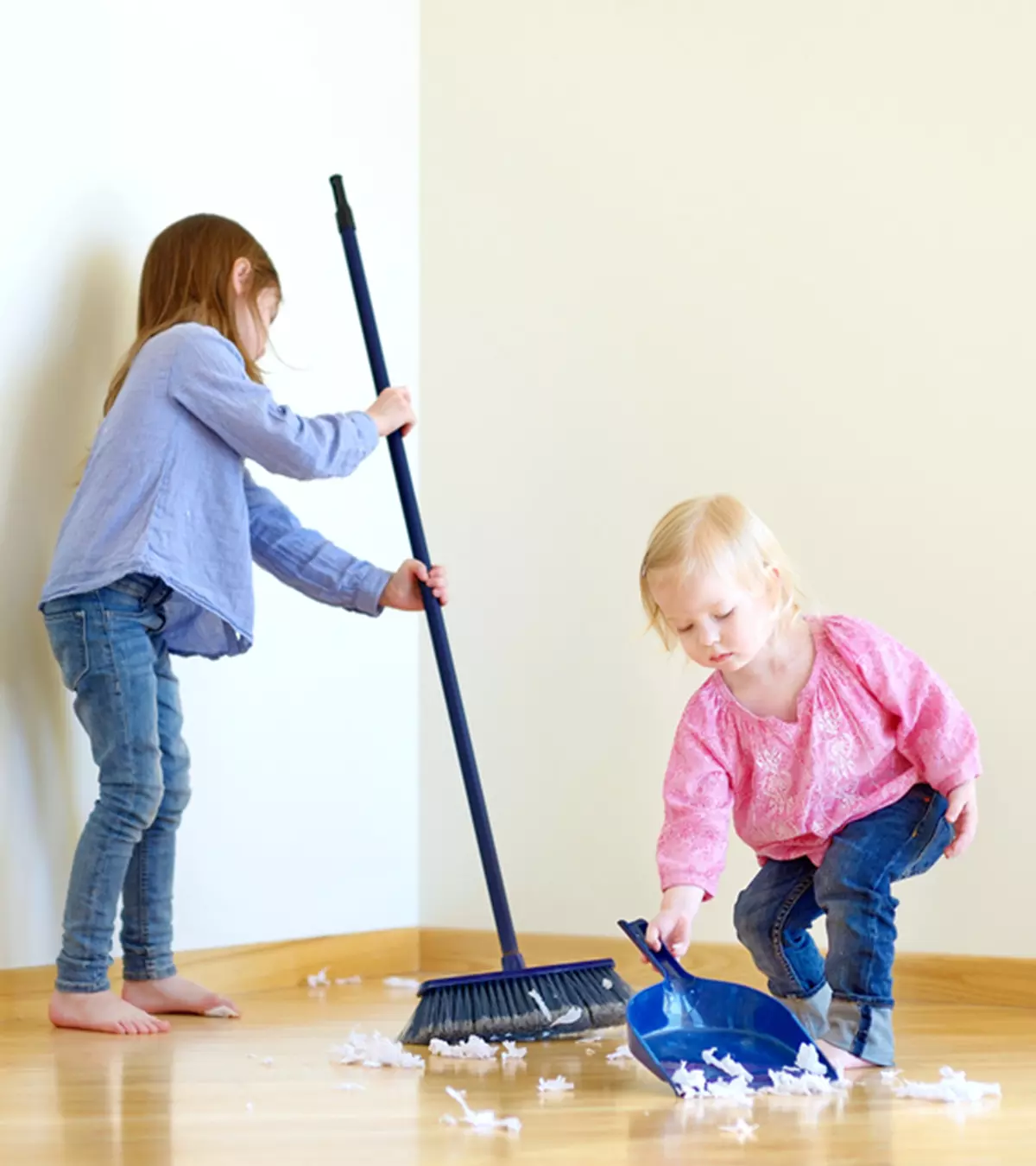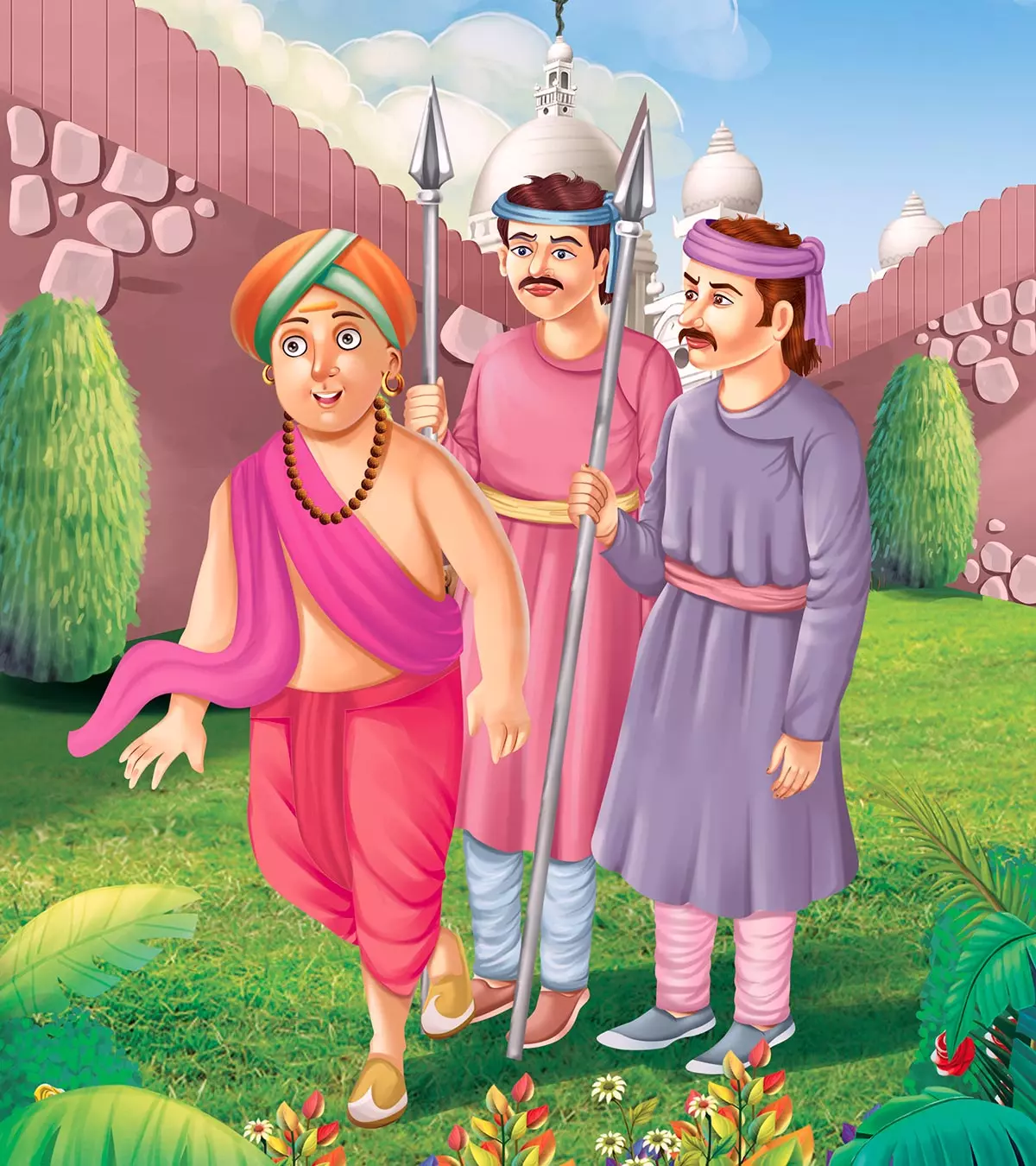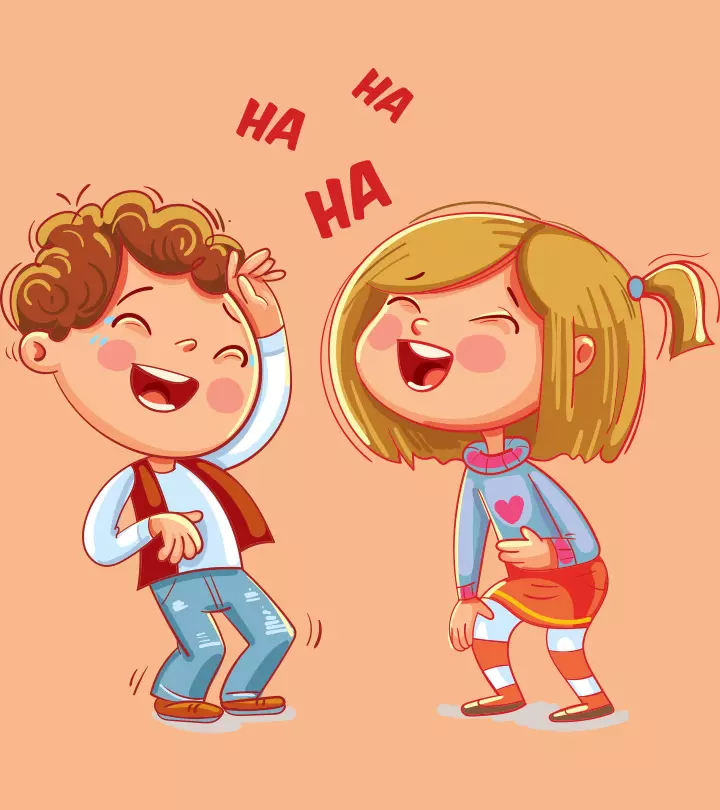
Image: Midjourney/ MomJunction Design Team
Brain development in childhood is crucial as it lays the foundation for growth later in life (1). Hence, parents should focus on the brain development of their child along with physical growth. Brain games for kids act as an exercise to sharpen a child’s brain and improve its functionality. Just like the body, the brain also needs activities to grow and function better. Delve into this post for some of the best brain games that will serve as entertainment for kids and help them improve their mental abilities. These games develop essential cognitive skills like problem-solving, critical thinking, and memory enhancement, making them valuable resources for parents and educators.

Key Pointers
- Brain games aid cognitive development and functionality.
- One Word Story and other games promote creativity in children.
- Memory games, puzzles, and Rubik’s Cube enhance problem-solving and concentration skills.
- Word games such as Pictionary and crosswords enhance language and communication abilities.
40+ Smart Brain Games For Kids
You may introduce age-appropriate physical activities, puzzles, word games, teasers, riddles, and other activities to exercise your child’s gray cells and aid in their cognitive development. These games are suitable for children in preschool and middle school.
Brain Training Activities
The more active the brain, the better it develops. Here are a few activities designed to engage the child’s mind by means of logic and boost brain development.
1. I spy with my eye

A classic game that has been played by generations, I Spy with My Eye makes the child more observant of the surroundings and helps them use their deduction skills. This is the perfect game to play with younger children while you wait for something, such as a doctor’s appointment, in a queue at a restaurant or on a drive.
What you will need: Eyes, ears, and imagination; time
How to:
The idea of the game is to make the kids look at the world around them and wonder about the little mundane things we take for granted.
- Look around the room and pick an object, but do not reveal what it is.
- Then say “I spy with my eye something…” and then mention a feature of an object, such as its color, shape, or size. For example, “I spy with my eye something blue or round or spiky.”Give the child a chance to guess what it is each time. Keep giving more clues by sharing more features of the chosen object.
- The participants can take turns to pick objects while the others guess what they are.
 Did you know?
Did you know?2. The brain-body coordination activity

We function efficiently when the brain and the other parts of the body work in tandem. This activity helps improve motor coordinationiThe ability of bones, muscles, and nerves to function together to make small, fine movements in children.
What you will need: Space to move around freely, stretch and bend
How to:
You can try different activities to achieve the goal i.e., brain and body coordination. We have listed a few examples below.
- Wiggle your toes: Get the children to sit on a chair with their feet dangling. Take off any shoes or footwear they have on and ask them to move only the toes on both feet up and down, or round and round. You can also ask them to move only two big toes, or just the toes of one foot so they learn how to exercise control on the body movements.
- The other hand: Every time your brain sends out an instruction, your dominant hand takes over the job. But this time, ask the child to use the other hand to help improve their coordination. If they are right-handed, ask them to use their left hand and vice-versa. Start with simple and safe tasks, and try harder tasks once they learn how to use the other hand better.
- Rub your belly while patting your head: This is a tricky coordination activity that you can try with the older kids. It is not easy and will need a lot of practice and concentration, which help in the development of the brain.
3. Pretend play

Pretend play helps develop a child’s social and emotional skills, critical thinking abilities and language skills. It also exercises the child’s working memory, as they try to stay in character and display behaviors accordingly.
What you will need: Ideas, scenarios, props if needed
How to:
Pretend play is at its best when children use their imagination and create scenarios and situations that they have to deal with. But sometimes, the caregivers may nudge it.
- Create a list of scenarios or situations that the children can enact. Don’t give too many instructions – just pick a scene and let the children use their imagination to play.
- Examples include shopping at a supermarket or being a doctor, banker, firefighter etc.
- Make a box of props using old clothes, accessories, and objects and keep it in the children’s room or the classroom. Encourage children to use them for pretend play.
4. One word story

This group activity lets the children build a story, one word at a time. It is one of the best educational activities for kids that encourages them to put on their creative thinking hats while ensuring they don’t stray away from the theme.
What you will need: Space to play, themes if any
How to:
- Make the children stand in a circle, facing inside and each other.
- Pick a child at random and ask them to start the story with a word. You can pick any word you like, such as ‘once’, ‘yesterday’, and ‘suddenly’ to begin with and the children have to choose a word to continue it and finish the sentence.
- They have to build the story until it comes to a conclusion or the moderator says stop.
5. Rhyming Words

This group activity enhances children’s linguistic skills and is a fun way to let them bond with each other. Although a simple game that requires no tools, it allows one to exercise their poetic skills and makes kids more social around their peers.
How to:
- Have the children form a circle and face towards each other.
- Ask a child to say a word aloud.
- The next child must then offer a word that rhymes with it.
- Ensure each child contributes until they are unable to think of a word that rhymes.
6. Catch The Thief

This game brings a lot of anticipation and excitement to the table. It requires a minimum of three players and is suitable for all ages. Plus, the game does not require fancy gadgets or tools, making it the ideal way to pass the time when camping or lounging at home.
What you will need: Chits of paper, pencil/pen
How to:
- Write ‘police’ on one chit and ‘thief’ on the other. Keep the remaining chits blank.
- Fold the chits to conceal the writing and distribute them among the players.
- The one who draws the police chit has to identify the player with the thief chit.
- A correct identification leads to the disqualification of the player with the thief chit, while an incorrect one disqualifies the player holding the police chit.
- The game continues until only two players (winners) are left.
7. Memory Game

The classic brain game boosts a child’s ability to recall things that they have learned recently, strengthening their memory power and mental agility.
What you will need: Space to play, flashcards if you have
How to:
You can play the game with or without flashcards.
With flashcards: This is suitable for one or two players.
- Get a set of memory game flash cards, which have two cards for each symbol or sign.
- Mix the cards thoroughly and arrange them face down on a table.
- The player turns a card face up and then turns it back while making a mental note of the symbol.
- The idea is to remember the position of the cards and uncover them correctly to pair them up. The game is over when all cards have been paired.
Without flashcards: This is ideal when you are traveling and do not have flashcards.
- Sit in a circle and pick a theme: cities, animals, objects, foods etc.
- The first player starts the game by saying a word. The next player has to repeat the previous player’s word and add a new word to create the list. The next player does the same, and the number of words on the list continues to grow.
- The players have to list all the words in the right order at every turn.
- Anyone who misses the order or changes it is out.
- The last one standing is the winner.
Besides these screen-free activities, puzzles can also support brain development in children.
8. Junior Scrabble

A much-loved classic, Scrabble is excellent for improving children’s vocabulary. The game is also easy to understand, allowing family members of all ages to participate during game nights.
What you will need: A scrabble board and letter tiles.
How to:
Allocate each player a set of letter tiles, which they must strategically arrange to construct words on the board. Longer words earn them more points. Incorporate advanced vocabulary or themed word rounds to enhance the fun factor.
Puzzles For Brain Development
Puzzles can effectively engage the child’s brain, exercising their problem-solving and analytical analytical skillsiThe general ability of a person to find a reasonable conclusion or solution to given problems . Jigsaw puzzles and block puzzles are educational, promoting hand-eye coordination and gross motor skillsiAbilities that let us do tasks where one needs to engage the large muscles in the legs, arms, and torso . Here, we have listed a few puzzles appropriate for children.
9. Sudoku

Sudoku is a number-placement puzzle that has a 9×9 grid with numbers in a few boxes. The goal of the player is to fill in the remaining slots with the appropriate numbers such that a number appears only once in each row and column of the puzzle. The player has to use numbers from 1 to 9 to fill the grid in as little time as possible.
 Trivia
Trivia10. Rubik’s cube

A Rubik’s cube is an excellent tool to keep the child engaged on long road trips or when there’s a lot of waiting period. Each side of the cube is differently colored, with nine small squares on each side. The goal is to get all the same-colored squares to one side in as little time as possible. The cube is an excellent tool to sharpen the brain through strategy, enhance concentration and improve the child’s spatial awarenessiBeing conscious of your surroundings and where you are in relation to them .
There are 43 quintillion ways to solve the cube, which means every time a child plays with it, they will enhance their skills.
 Did you know?
Did you know?11. Count Down
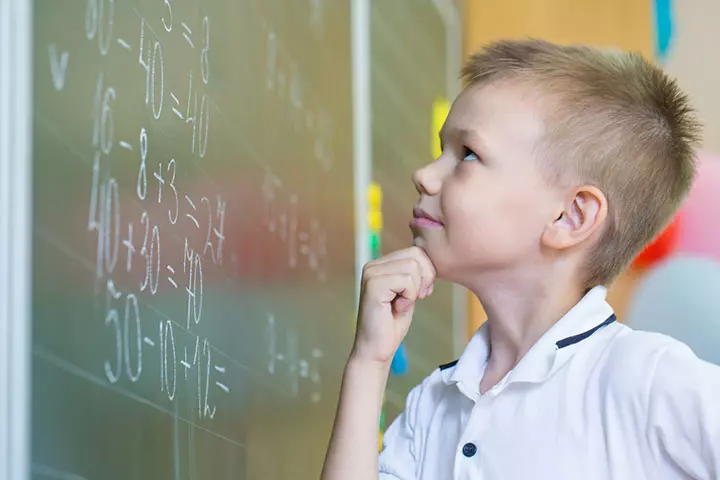
The game Count Down makes learning numerical skills less daunting by adding a playful angle. It also encourages quick thinking, improves focus, and helps kids develop cognitive skills and understand the connection between numbers. Here are a few prompts to let you and your children play this game.
Ask the child questions such as
- Ask them to name five numbers after 20.
- Ask them what number comes after 8.
- Ask them to count backward from a number.
- Or ask them to identify prime and odd numbers.
12. Chronology

A deck of cards offers many opportunities to keep children occupied. One such game is chronology, which not only engages the kids but also helps improve their counting and number identification skills.
What you will need: A deck of cards
How to:
- Deal the deck equally between the players.
- Everyone has to keep playing the lowest-value card.
- The players keep playing until one of them gets the ace of a suit.
The game continues with the last player starting the next sequence by putting out the lowest card.
13. Mazes
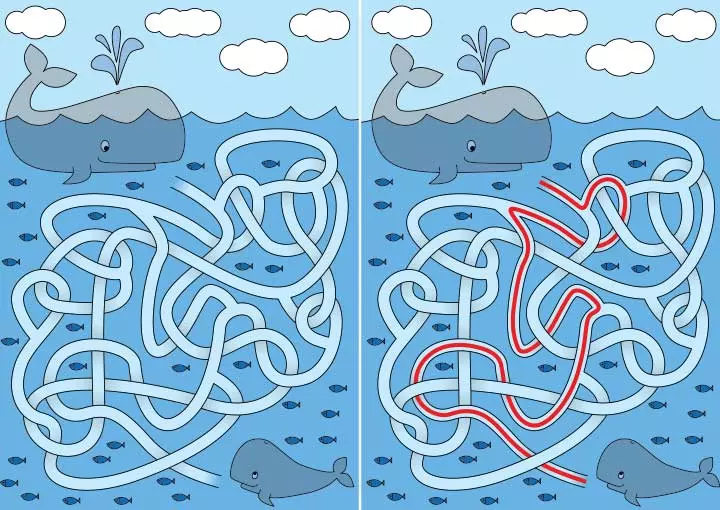
Should you go left? Right? Wait, weren’t we here before?
Being in an actual maze is thrilling and can help a child’s sense of directions and observation skills. Mazes on paper are equally interesting, as they boost the visual and motor development skills, problem-solving ability, and fine motor development. The more the number of mazes a child solves, the faster they get at solving them.
What you will need: Ready-to-use maze puzzle books or sheets, pencils, and erasers
14. Jigsaws
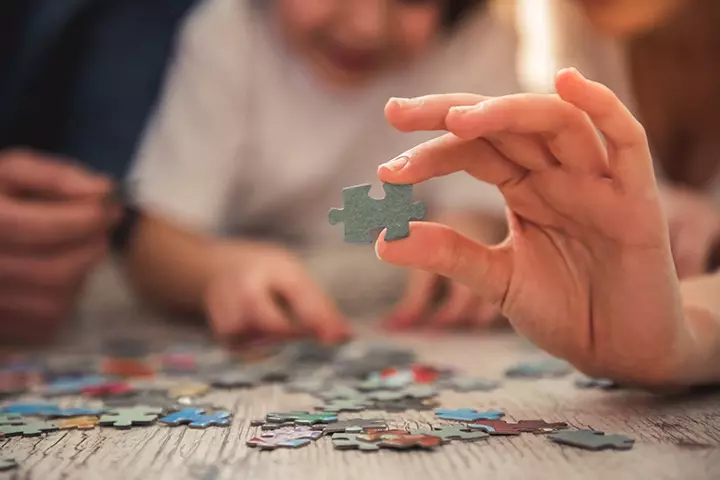
Jigsaw puzzles are simple and easy to solve for younger kids. These problem-solving activities for toddlers also contribute to the child’s cognitive development by enhancing their reasoning skills, visual perceptioniThe ability to observe and interpret our environment through the information we get through our eyes , and spatial awareness, along with fine motor skillsiA skill where one needs to use the small muscles in hands, fingers, and wrists . Jigsaw puzzles improve a child’s shape recognition skills and the ability to recreate what they see by putting all the pieces together.
Usually, jigsaws have 20-30 pieces. You can try larger and more complicated puzzles with more pieces for older kids and teens.
15. Checkers

Another classic game on our list is Checkers, also known as draughts. This game requires two players and a lot of analytical thinking. While its simple rules allow everyone to enjoy the game, it keeps the players interested and engaged for hours with the many possible moves.
What you will need: A checkers board and units
- Place the units on alternate squares of the board.
- The units should be moved diagonally.
- The aim is to capture the opponent’s units by jumping over them.
The first one to capture all of the opponent’s units or one who jumps the highest units is the winner.
16. Brainteasers
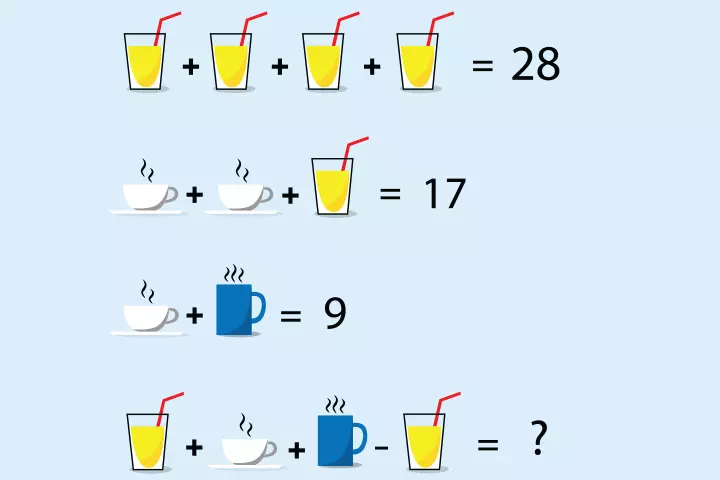
Brainteasers are nothing but riddles that make you think. Often in the form of a question, brain teasers compel you to deduce the answer with the help of clues that are in the question itself. Here are a few examples of brainteasers for children.
- What belongs to you but is only used by the others?
Answer: Your name - Why can’t a man living in Scotland be buried in England?
Answer: Because he’s living, and we only bury the dead. - A truck drove to a village and met four cars. How many vehicles went to the village?
Answer: One truck - Feed me, and I will grow. Give me a drink of water, and I will die. Who am I?
Answer: Fire
17. Tangrams: Jigsaw With A Twist
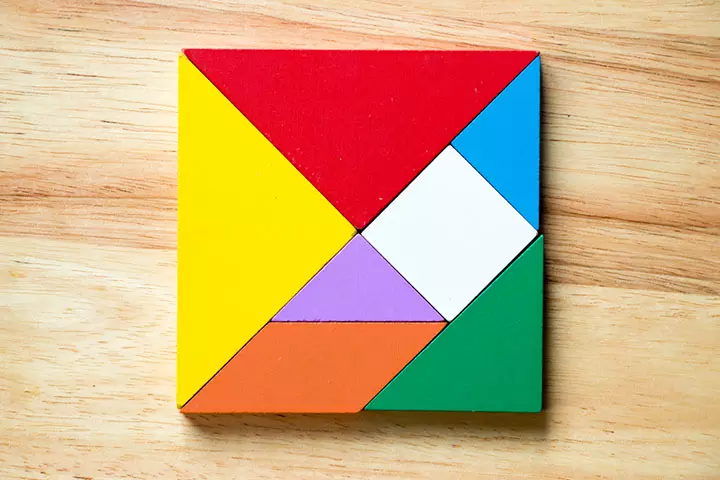
If your child is new to the Jigsaw world, then Tangrams could be an uncomplicated entry into this versatile and adaptable game.
What you will need: A square border and seven polygon cutouts
How to:
Start by arranging the shapes into a square, and give the child a minute or two to memorize the pattern. The objective of the game is to recreate the design as quickly as possible. As there is no end to the number of designs one can make in a tangram, children are unlikely to grow bored of it.
Quick tip: Complicated designs and a timer can make gameplay more intriguing.
18. Chess
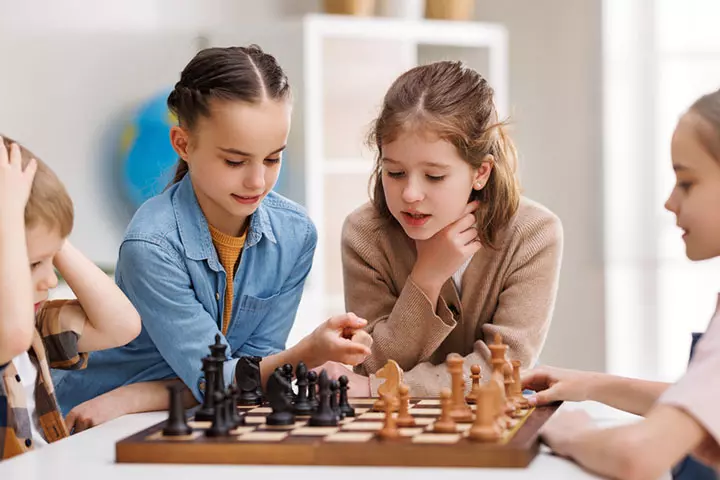
An all-time classic, this game is a good way to develop your child’s cognitive skills and boost their creativity. Moreover, teaching the child the name of each chess unit and how it moves can be an excellent way to spend quality time with the child.
What you will need: A chess board and units
Arrange the chess pieces on the board and explain how each piece moves. For instance, the queen may only move in a straight line, either vertically, horizontally, or diagonally. The objective is to guard one’s king while strategically maneuvering the units to checkmate the opponent’s king. The more times one plays the game, the more adept they are likely to become at this game’s moves and strategies.
19. Snakes And Ladders

When you want to keep the kids away from screens, pull out a fun game like Snakes and Ladders, which has entertained people for generations. All this game requires is a dash of strategy, a touch of luck, and an active brain to ensure no one takes that extra step. In exchange, the game helps improve their numerical and cognitive skills.
What you will need: A Snakes and Ladders board
How to:
Players have to select a unit and take turns to roll the dice to move it forward. The goal is to be the first one to reach the number 100 or the 100th square. Landing on a number with a ladder moves the unit forward by multiple numbers or squares. However, one has to be cautious as landing on a square marked with a snake sends the unit backward. Overall, this game is full of anticipation, excitement, and fun.
Physical Activities and Exercises That Work The Brain
Not all games that work the brain need you to sit in one place. Here are a few activities that keep you fit physically and mentally.
20. Scavenger Hunt

Scavenger hunts are fun and warrant quick thinking and action, compelling the children to exercise their working memory. Scavenger hunts for kids can be organized indoors or outdoors too, where the kids will have to indulge in some physical activity such as walking, running or climbing.
What you will need: Small objects that are easily hidden and safe places where you can plant them. Ensure a hunt that is not too easy or difficult. Also, make sure the path or places you choose to hide the objects are safe for kids.
21. Musical Chairs

Musical Chairs is one of the best games for making physical activity fun. This dynamic game has it all: music, laughter, lots of running around, and tons of fun.
What you will need: Chairs and a device to play music.
- Initiate the game by arranging the chairs in a circle, ensuring ample space for movement.
- Play some fun music and ask the children to dance around.
- Stop the music abruptly, and the player left standing is eliminated.
- The game continues, and one chair per round gets removed until only one player (winner) remains.
22. Reach The Bin

Kids love tossing things around, and this game turns that process creative. This game forces them to concentrate and decide on how fast, slow, and from what distance they should throw an item for it to reach the bin. Plus, it requires minimal setup and can be enjoyed indoors or outdoors.
What you will need: A bin or basket and small objects such as foam balls or rolled-up paper.
How to:
- Position the bin or basket at a reasonable distance from the players.
- Distribute the throwable objects among the participants.
- Award points for successful tosses, with varying point values depending on difficulty.
- The participant with the highest points becomes the winner.
Quick tip:
Add obstacles between the basket and the player to enhance gameplay.
23. Obstacle courses

Obstacle courses exercise the brain-body coordination and improve the child’s kinetic skills, agility and problem-solving. Set up an indoor or outdoor course that challenges the child mentally and physically. A well-set obstacle course should make the child crawl under something, jump over, climb over, hop, skip, and walk. It is one of the best cognitive activities for toddlers that helps boost early brain development and helps the child gain better control over their physical movements.
What you will need: Chairs, cushions, string or rope, hula hoops, a tub of water and a timer. You can also use other objects that may help you chart the course better.
24. Hooping

In addition to being fun, hula hooping is a comprehensive workout that requires concentration, memorization of sequences, and coordination of the brain and body. It helps tone the muscles and enhance flexibility. Moreover, its rhythmic movements can provide a soothing effect, making it the ideal way to keep kids active and healthy.
What you will need: Hula hoops
How to:
- Give each child a hula hoop.
- Make them stand with their feet apart and place the hoop around their waist.
- Ask them to shift their weight using side-to-side hip movements.
- Arrange competitions to see who can hula hoop the longest.
25. Hopscotch
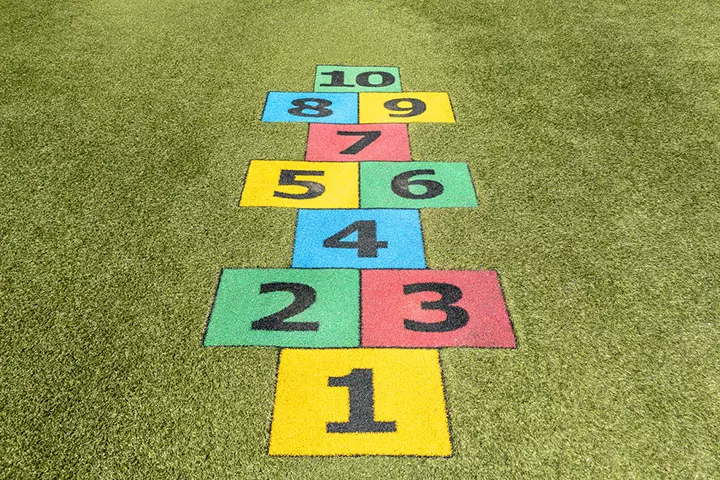
Hopscotch is a timeless classic for promoting physical activity among children. It’s an enjoyable way to enhance the child’s balance and counting skills and keep them away from screens.
What you will need: Chalk or tape and a stone
- Begin by drawing squares on the ground and numbering them.
- Make the players take turns throwing the marker onto a numbered square.
- Each player hops through the grid, skipping the square with the stone, and retrieves the stone on their way back.
- The game continues until one player completes the grid.
26. DIY Car Run

If your little one is a car enthusiast, this game is just for them as it allows them to transform household items into a thrilling race track for their beloved toy cars. This hands-on activity is an excellent way to enhance a child’s problem-solving skills and creativity.
What you will need: A few toy cars and household objects that can serve as tracks and obstacles
How to:
- Make the kids gather things around the house suitable for a car run.
- Guide them in arranging the components into a functional track.
- Watch them use their skills to arrange and rearrange the objects to make the car move smoothly.
27. Stacking Or Nesting Toys

Stacking or nesting toys may seem like a simple activity for babies and toddlers. But it has the potential to enhance early brain development while improving the child’s fine motor skills and hand-eye coordination. Picking up items exercises the fingers while the act of placing them on top of the other objects exercises the hand-eye coordination.
Stacking or nesting also works on the depth perception of the child. For older kids, you could make them stack cubes or chairs or other materials to make a tower that stands tall.
What you will need: Stacking or nesting toys for younger kids and toddlers, materials that can be stacked for older kids; space to play.
28. Hide And Seek

Hide and Seek is a traditional kids’ game that requires quick, strategic thinking and deft movements. As for its benefits, it keeps the kids on their toes and makes them aware of their surroundings. And being a screen-free group game, it is ideal for all settings.
How to:
- Make one player the seeker.
- He or she should shut their eyes and count to a predetermined number.
- The other players should hide.
- Next, the seeker should look for the players who are hidden.
- The player to be located becomes the next seeker.
The game goes on until the last player is found.
29. Simon Says

Simon says is a classic game played at schools and parties. The game may seem simple at first but can get challenging as you play. Whether you play with just a handful of kids or big groups, the game never gets boring. Simon says helps improve the child’s listening, interpretation, and social skills.
What will you need: Space to play, a small or large group of children
How to:
- The game begins with one person being ‘Simon’, who gives commands to the other players.
- The children have to listen to what Simon says and follow them. For instance, Simon says, jump, bend and touch your toe, pat your head or stand on one leg.
- But here is the catch here — the other kids must follow the commands only if the sentence begins with ‘Simon says’. If it doesn’t, and the other children still follow the commands, they lose points.
- The player with the highest number of points wins.
30. Neighborhood Map Quest

Charting a map is not easy. But who’s talking about a treasure map or even a world map? We only want the child to draw his or her own map of the neighborhood on a piece of paper. This activity aims at improving their knowledge about their surroundings.
What you will need: A3 or A4 size papers, pencils and erasers, rulers, crayons or sketch pens
How to:
- Give the kids a sheet of paper and pencils or crayons.
- Ask them to go around the neighborhood for a quick look of the area. Escort them and allow them enough time to observe the surroundings and make a note of them mentally.
- Once they are back to the classroom or the house, ask them to draw the map based on what they have seen.
This activity encourages their spatial thinking abilities and teaches them the basics of mapping, routing, and direction.
31. Sorting

This game tasks the children to group items based on their distinctive functions or characteristics and helps enhance their cognitive skills. It could also help with everyday categorization abilities such as sorting one’s clothes, utensils, and study materials.
What you will need: Everyday objects
How to:
- Give a variety of objects to children.
- Explain how they should sort objects into groups based on their designated function or purpose (e.g., writing utensils, eating utensils).
- Assist children in identifying groups by discussing the objects’ similarities and differences.
Reinforce the concept by introducing additional sets of objects for sorting.
Pen And Pencil Brain Games
When the weather is not ideal for outdoor activities, you can try these pen and pencil brain games to keep the kids busy and improve brain development.
32. Dots And Boxes

This is one of the oldest games played in classrooms, office meetings and at home! The simple game with a set of dots on a paper can keep the kids occupied during long rides or free hours at the school. The game is for two players.
What will you need: Paper and pen or pencil
How to:
- On a plain white paper, make a square of dots. Start with a smaller square (6×6) and then move on to a bigger square (9×9 or 12×12).
- Two players take turns, using different colored pens to join two dots to make a line.
- The aim is to be able to join dots to form squares. When players complete a square with their line, they score a point and get to put their initial in that box.
- The person with the highest number of boxes with their initial in it wins.
33. Tic Tac Toe

A game of Xs and Os, tic tac toe features a 3×3 grid with one player choosing the X and the other choosing O.
What you will need: Paper, pens or pencils
How to:
- The game is played between two people. It starts by drawing a grid, by crossing two parallel and perpendicular lines, forming nine squares.
- The first player begins by placing an X in one of the squares.
- The other player puts an O in another square.
- The players keep adding Xs and Os to try and get three Xs or Os in a row: horizontally, vertically or diagonally.
- The player who gets three Xs or Os in a row wins, although in most cases, the game ends in a draw.
34. Story Scramble Relay

This versatile literature game is a creative way to enhance kids’ imagination and story-telling skills. It serves as both an icebreaker and an activity to build social skills as it requires teamwork and interaction.
What you will need: Paper, scissors, and markers
How to:
- Divide the children into two groups.
- Split the sentences of a story into separate pieces of paper.
- The goal is to come up with a story using these sentences.
- Make the teams take turns to pick a paper.
- Allow them to return a paper or sentence if it does not match their story.
- The first group to make a coherent story from the scrambled sentences is declared the winner.
35. Paper telephone

Paper telephone is a fun game that encourages a child’s interpretation skills, drawing or artistic abilities. The game is played by at least three to as many as ten people.
What you will need: A paper and pencil or pen.
How to:
- The players are given a word or theme or object that they must depict in the form of a picture at the top of the page.
- Once done, they pass the paper to the next player, who writes a caption and folds it to reveal only the sentence and not the image before passing it to the next person.
- The next player has to draw an image to go with the caption and folds it so that only the second image is seen, before passing it to the next player.
- The game continues with participants writing a caption and drawing the image alternately until there is no more room on the paper.
The results are amusing, but the game is suitable for older kids and teens.
36. Pictionary

Pictionary is similar to charades, except here, the players have to draw the clues on a board instead of enacting them. The game enhances the child’s creative thinking abilities, communication skills, and interpretation skills.
What you will need: A white or blackboard, marker or chalk, list of topics, movie names or objects.
How to:
- This is a game for groups. Divide the kids into groups of two or more, depending on the size of the group.
- One member from each group is chosen and given the topic to depict through an image or picture. The rest of their team members must guess what the word or theme is.
- The team that gets it right gets points.
 Did you know?
Did you know?37. Dot Pattern Art
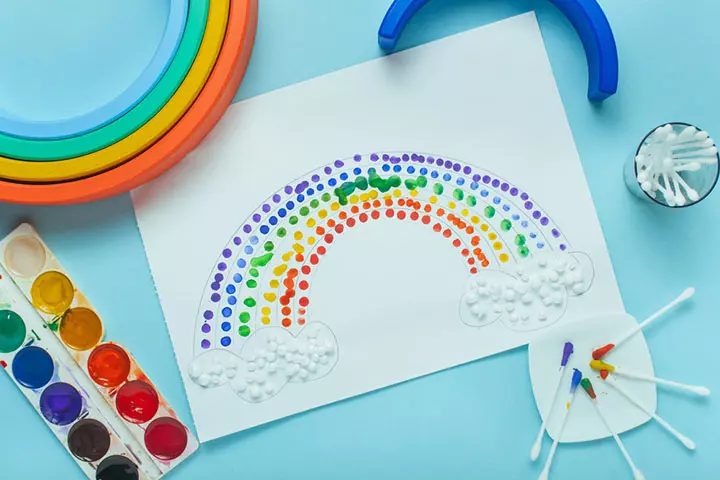
Although a little trickier than conventional drawing activities, dot-pattern art is excellent for maintaining a child’s focus. This art form only requires a few art supplies, usually found at home, and allows for abstract and niche designs. It can help kids exercise their motor skills, grasping skills, and hand-eye coordination.
What you will need: Watercolors, brushes, and paper
There are two ways to facilitate this activity.
- Freestyle:Allow the kid to make independent design choices.
- Guided method:Trace a design onto the sheet and make the child put colorful dots into it.
Regardless of the method, dot-pattern art helps improve the kid’s imagination and provides hours of creative engagement.
38. Crossword
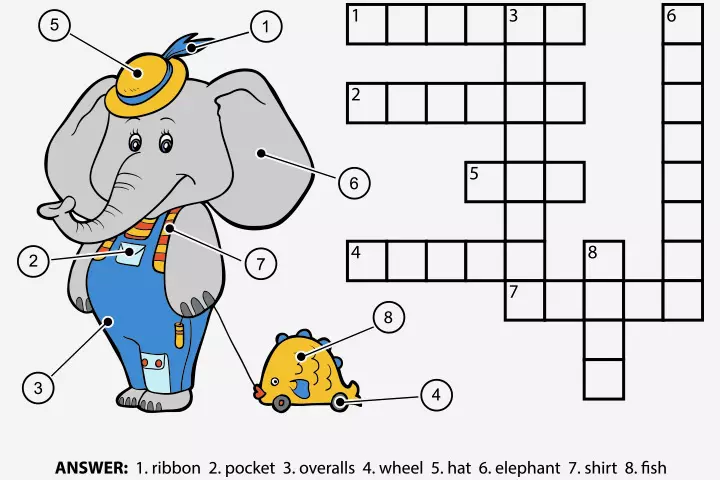
When you are going on long drives or to places where the kid will have nothing to do but wait, a crossword puzzle could come in handy. Crossword puzzles are among the top tools to keep the brain active and hone the child’s vocabulary. Some studies also suggest that crosswords help improve the memory function of the brain and intelligence.
Each puzzle is a grid of empty squares that should be filled with the right word based on the clues given. The more a child works on crosswords, the better he or she will become at solving it.
What you will need: Crossword puzzle books or sheets picked according to the child’s age, pencil and eraser.
39. Color Mixing

Making your child learn about different colors and helping them develop an understanding of color theory become easy with color-mixing games. This hands-on activity allows them to experiment by mixing different primary, secondary, and territory colors independently and discovering the results they give.
What you will need: Different color paints, brushes, bowls, or paint pallets
Give the child a bunch of colors, and let them mix them. You can also guide them if you want to explain the results that mixing of particular colors provides. Additionally, make the child note down the colors they have mixed and the results they give to further enhance their color recognition skills.
40. Spot The Difference

Use the Spot the Difference game to hone your children’s observational abilities and make the most of their unique perspectives. And the best part? It can be played individually or in groups.
What you will need: A pencil or pen and a printout of identical photos with slight changes
Provide the child two identical images from their favorite TV show or story, each with a few small differences. Ask them to point out the differences. Give them hints or tell them how many differences to look for to make the game more engaging. A timer can also be added to increase the enjoyment.
41. Rebus Puzzle
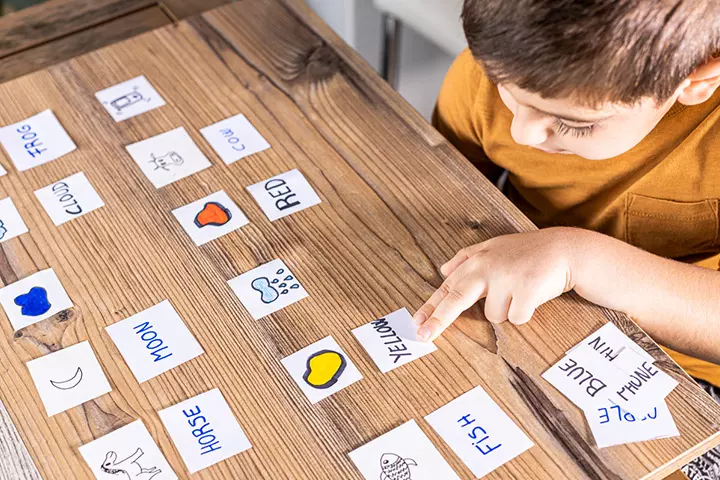
Rebus puzzles represent a word or phrase using pictures, symbols, and letters. To play, provide children with a series of images and symbols that, when read together, form a meaningful phrase or word. For example, a picture of an eye followed by a heart symbol and an image of a sheep may represent ‘I Love Ewe.’ Similarly, children must interpret the visual clues to solve the puzzle. Puzzles are considered beneficial for children’s cognitive development (2). They enhance critical thinking and problem-solving skills by challenging children to think outside the box. Hence, a Rebus puzzle can be a brain exercise for children.
Frequently Asked Questions
1. How can kids improve brain activity?
You can encourage improved brain activity in children by exposing them to a variety of activities such as reading, singing, sports, and engaging in math, languages, science, and arts. You should also teach your children interpersonal skills such as kindness, empathy, and teamwork to ensure proper brain development (1).
2. What is the purpose of brain training for kids?
Brain training for children includes fun and intense online games that help them improve their attention, learning, and memory skills. It also assists children in retaining knowledge and information, processing them, improving working memory, and being more cognitively adaptableiThe ability to effectively adapt to the changing environment (2).
3. How can parents incorporate brain games into their child’s daily routines?
Parents may allot a specific time every day for brain games such as puzzles, riddles, and memory games or include them in their playtime. They may also turn chores into games, such as categorizing objects or counting while cleaning up. Furthermore, encouraging them to read and engaging in a discussion can also aid in their brain development.
4. How early can parents introduce brain games to their children, and are there any age-appropriate games?
Parents can introduce brain games to children as early as six to nine months. They can start with simple games such as peek-a-boo, stacking blocks, or putting toys in buckets during the first 18 months and gradually move on to more complex ones such as sorting, counting, and matching games when they turn two or three years old (3).
5. Can playing brain games improve a child’s academic performance?
Brain games train children to think a certain way and enhance their memory, ability to recall, solve problems, and overall cognitive skills, which may help them with their school subjects, such as math (4).
6. What should parents consider when selecting brain games for their children, and how can they assess their child’s progress?
Parents may look for age-appropriate games that address a child’s weaknesses and help strengthen or develop the skills they lack. Moreover, brain games that take a fun approach to learning and help keep the children engaged, such as those involving colors, music, or physical activity, can be ideal choices. Furthermore, their progress may be assessed by monitoring their scores, speed, or accuracy with each advancing level, discussing, and taking feedback on their schoolwork.
7. Can playing brain games have any negative effects on children, such as addiction or overstimulation?
Playing brain games on devices may lead to screen addiction and reduced physical activity. Moreover, extended hours of these games may overstimulate their brain, leading to exhaustion which can, in turn, impact their overall health. So, parents need to ensure children spend only a stipulated amount of time playing brain games while simultaneously engaging in outdoor plays and taking time to rest.
8. How can teachers incorporate brain games into their classroom curriculum to help students learn better?
Teachers can use educational games that are in line with the curriculum. They can use brain games as warm-up activities or a way to review concepts taught in class. Teachers can also customize the games targeting specific learning goals and making learning engaging and interactive for students.
9. What types of brain games enhance children’s creativity?
Games that promote storytelling, like Pictionary and One Word Story, are great for boosting creativity in children. These games encourage them to think creatively and express their ideas in fun, imaginative ways.
Cognitive development in children is as important as their physical development. Playing games is one of the several factors that influence the brain’s functioning. Activities, including puzzles, word games, or riddles, help in better brain engagement, thus improving cognitive skills. These brain games for kids are suitable for different age groups. Pick those that suit your children and help them exercise their minds more than before. Also, while playing these games, don’t let it seem like a task. Keep the fun alive because children learn better when they enjoy something.
Infographic: Brain Games For Children
Studying or reading books is not the only way to boost brain function and activity in children. One can do that with the help of games and activities too! Yes, that is right. In the infographic that follows, we have put together a few game ideas that you can arrange for your child to boost their cognitive function along with having too much fun. So, read on and explore.
Some thing wrong with infographic shortcode. please verify shortcode syntax
Illustration: Innovative Brain games for kids
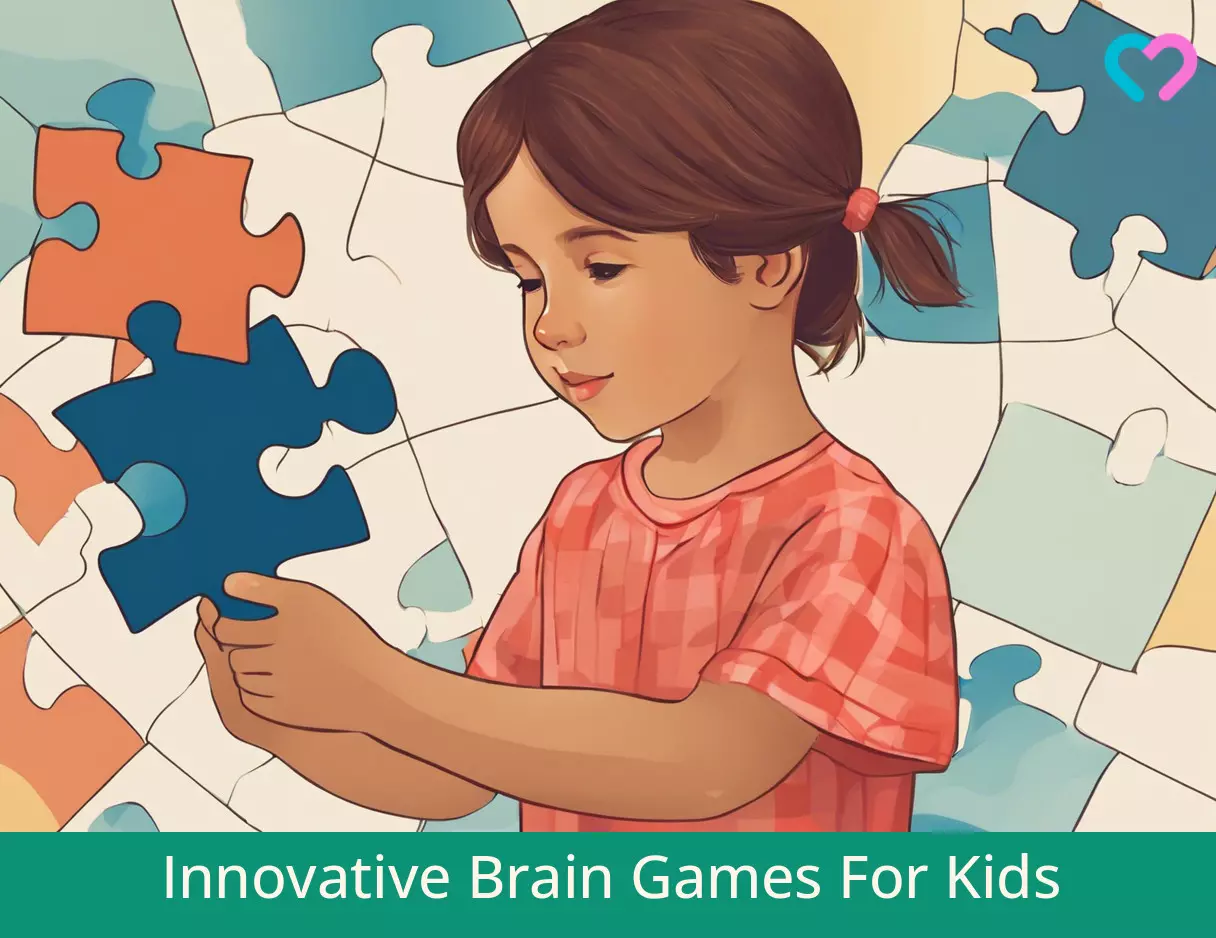
Image: Stable Diffusion/MomJunction Design Team
Sharpen your visual memory with this interactive and enjoyable video! Master techniques to enhance your memory skills and embark on a captivating journey of image recollection.
References
- Adrienne L. Tierney et al.; (2009); Brain Development and the Role of Experience in the Early Years.
https://www.ncbi.nlm.nih.gov/pmc/articles/PMC3722610/ - S.C. Levine et al.; (2012); Early Puzzle Play: A predictor of preschoolers’ spatial transformation skill.
https://www.ncbi.nlm.nih.gov/pmc/articles/PMC3289766/ - Why Ages 2-7 Matter So Much for Brain Development.
https://www.edutopia.org/article/why-ages-2-7-matter-so-much-brain-development - What Can Brain Training Really Do for Kids?
https://childmind.org/article/can-brain-training-really-kids/ - Why play? Early games build bonds and brains.
https://www.health.harvard.edu/blog/why-play-early-games-build-bonds-and-brain-202302022884 - What Can Brain Training Really Do for Kids?
https://childmind.org/article/can-brain-training-really-kids/
Community Experiences
Join the conversation and become a part of our nurturing community! Share your stories, experiences, and insights to connect with fellow parents.
Read full bio of Kristen Miller
Read full bio of Sagari Gongala
Read full bio of Harshita Makvana
Read full bio of Trisha Chakraborty






